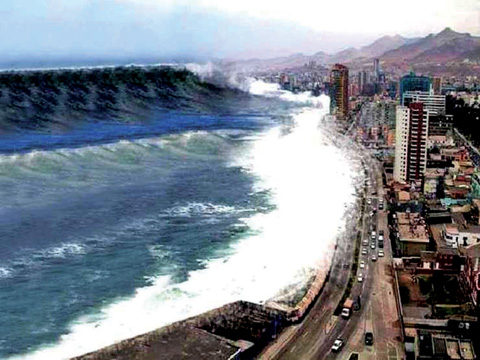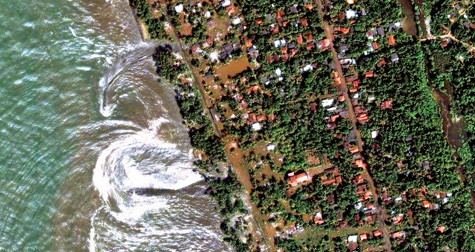Indian Ocean tsunami - a decade after
By Pramod De Silva
Where were you at 9.36 a.m.on December 26, 2004? That has become one
of the definitive questions such as "where were you on November 22 1963
when John F. Kennedy was shot?." It is a moment that we will all
remember, as long as we live. Indeed, the Indian Ocean tsunami is THE
most catastrophic event in living memory for many of us. And 10 years
have passed since that fateful day, which saw the deaths of nearly
240,000 people across 14 countries in Asia and Africa.
But at that exact time, no one in Sri Lanka (and I believe most other
countries) knew what was about to happen. The very word tsunami was
unknown to 99 percent of the population. I, for one, knew what it meant
but never in my wildest dreams did I imagine that I would see the
devastating effects of a tsunami in Sri Lanka itself.
 It was a harrowing day that simply has no parallel, even for a
country such as Sri Lanka which had suffered immensely due to a
protracted terrorist conflict. Triggered by a 9.15 undersea quake that
literally shook the Earth, the tsunami swept through coastal towns
reducing them virtually to cinders. It was a harrowing day that simply has no parallel, even for a
country such as Sri Lanka which had suffered immensely due to a
protracted terrorist conflict. Triggered by a 9.15 undersea quake that
literally shook the Earth, the tsunami swept through coastal towns
reducing them virtually to cinders.
Indonesia was the worst affected country (128,000 deaths) and Sri
Lanka was the second in line, with nearly 40,000 deaths island-wide.
The scale of the disaster became apparent only when the bodies began
to pile up, with most coastal areas reduced to rubble. By the end of the
day, many survivors had lost their entire families and properties,
leaving them completely helpless.
Oneness
However, this moment of despair gave rise to a feeling of oneness, of
unity that was perhaps repeated only when the country vanquished
terrorism five years later, in 2009. All the people got together as one
and rose to the challenge of helping the victims of the unprecedented
disaster, shedding all differences.
Foreign aid also poured in, for the immediate rehabilitation purposes
and reconstruction of damaged infrastructure facilities/private
properties.
The word - as well as the phenomenon - was etched deeply in the
collective conscience of a nation on that tragic day. Ever since, the
mere mention of the word is enough to instill fear in our minds.
There have been several tsunamis in other parts of the world since
then, most noticeably Japan (March 11, 2011), but nothing could come
close to the sheer scale of death and destruction caused by the Indian
Ocean tsunami of December 26, 2004.
Safety
The reconstruction of tsunami-hit areas is still a work in progress
and the authorities in all the countries have turned it into an
opportunity to "build back better".
Some areas are virtually unrecognisable and laws have been introduced
to ensure that no one dies from a future tsunami.
Asia has received a state-of-the-art tsunami warning system with
active and passive safety features while emergency services have been
geared to inform and evacuate coastal dwellers as fast as possible. With
almost everyone having a cellular phone, sending a warning text has
become a very effective approach.
Yet, we have still not reached perfection in this regard. A decade
after the Indian Ocean tsunami struck, the Asia-Pacific region remains
highly disaster prone and critical gaps remain in early warning,
especially in reaching the most vulnerable people and remote
communities, the United Nations Economic and Social Commission for Asia
and the Pacific (ESCAP) said early this week.
Critical gaps remain in early warning and additional investments are
required particularly at the local level, according to ESCAP. "Reaching
the most vulnerable people and remote communities at the 'last mile'
with timely warnings is critical," said an ESCAP spokesperson.
"An efficient end-to-end system is yet to be realised." There have
been warnings that 10 years after the Boxing Day tsunami, a degree of
complacency has set in to the detection and early warning process, which
should not be the case.
Impact
There is also a tendency towards taking 'natural' steps to stop a
tsunami in its tracks. For example, it was observed that places with a
heavy presence of mangroves and corals experienced only a minimal impact
from the tsunami. Many coastal villagers have taken this to heart.
|

An aerial view of the tsunami |
A few yards inland from the new post-tsunami coastline in Banda Aceh,
Indonesia, on land left waterlogged by the killer wave, the survivors
have planted 70,000 mangrove trees. The trees are growing well, and
villagers see them as protection against any future invasion from the
ocean.
The upside of all this is that we do know a lot more about tsunamis
now than at any other time. Numerous scientific studies and modelling
studies have been conducted post-2004 on the origin and spread of
tsunamis which could ultimately save many more lives should an undersea
quake or tsunami happen.
Fury
Unfortunately, earthquakes per se cannot still be predicted with any
degree of accuracy or certainty. One can only estimate the time it takes
for a tsunami wave to reach a particular destination after an earthquake
takes place.
It is difficult to find a rhythm to earthquakes, even though the last
major tsunami in Asia prior to 2004 had occurred probably in 1300-1400
AD. Indeed, a big undersea quake can happen tomorrow or in another 1,000
years.
The tsunami shattered the myth that Sri Lanka and surrounding
countries were "safe' from earthquakes or undersea quakes.
Now that we know the power and fury of the ocean, the damage it could
do, subliminally we will always fear and respect it.
On the other hand, the ocean is central to our lives as islanders. It
is a resource we cannot do without. It is an equation that we will have
to live with for the rest of our lives. We may obliterate all physical
traces of the tsunami, but it is not so easy to heal the mental scars of
thousands of people who had lost everything they cherished - their loved
ones, their belongings and their houses.
What do you tell to a then two-year-old child who had lost all his or
her family? Ten years down the line, he or she would be 12, but a
personal tragedy on that scale is hard to fathom and bear at any age.
We have to be one with them as we remember all those who perished
that morning as a ferocious sea engulfed the land.
|

